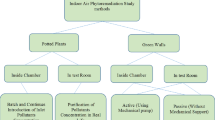Abstract
Atmospheric pollutant phytoremediation technologies, such as potted plants and green walls, have been thoroughly tested in lab-scale experiments for their potential to remove air pollutants. The functional value of these technologies, however, is yet to be adequately assessed in situ, in ‘high value’ environments, where pollutant removal will provide the greatest occupant health benefits. Air pollution in countries such as China is a significant public health issue, and efficient air pollution control technologies are needed. This work used pilot-scale trials to test the capacity of potted plants, a passive green wall and an active green wall (AGW) to remove particulate matter (PM) and total volatile organic compounds (TVOCs) from a room in a suburban residential house in Sydney, Australia, followed by an assessment of the AGW’s potential to remove these pollutants from a classroom in Beijing. In the residential room, compared to potted plants and the passive green wall, the AGW maintained TVOCs at significantly lower concentrations throughout the experimental period (average TVOC concentration 72.5% lower than the control), with a similar trend observed for PM. In the classroom, the AGW reduced the average TVOC concentration by ~ 28% over a 20-min testing period compared to levels with no green wall and a filtered HVAC system in operation. The average ambient PM concentration in the classroom with the HVAC system operating was 101.18 μg/m3, which was reduced by 42.6% by the AGW. With further empirical validation, AGWs may be implemented to efficiently clean indoor air through functional reductions in PM and TVOC concentrations.







Similar content being viewed by others
References
Aini Jasmin G, Noorizan M, Suhardi M, Murad A, Ina K (2012) The use of plants to improve indoor air quality in small office space Pertanika Journal of Social Sciences & Humanities 20
Al-Hemoud A, Al-Awadi L, Al-Khayat A, Behbehani W (2018) Streamlining IAQ guidelines and investigating the effect of door opening/closing on concentrations of VOCs, formaldehyde, and NO2 in office buildings. Build Environ 137:127–137
ASHRAE (2007) Standard 52.2-2007–Method of testing general ventilation air-cleaning devices for removal efficiency by particle size (ANSI/ASHRAE Approved) Am Soc Heat Refrig Air-Cond Eng
Aydogan A, Montoya LD (2011) Formaldehyde removal by common indoor plant species and various growing media. Atmos Environ 45:2675–2682
Bakó-Biró Z, Clements-Croome D, Kochhar N, Awbi H, Williams M (2012) Ventilation rates in schools and pupils’ performance. Build Environ 48:215–223
Buka I, Koranteng S, Osornio-Vargas AR (2006) The effects of air pollution on the health of children. Paediatr Child Health 11:513–516
Burritt K (2013) Survey of suitable plants for Cal Poly’s green wall. California Polytechnic State University, San Luis Obispo, California.
Chang Y-C, Lee H-W, Tseng H-H (2007) The formation of incense smoke. J Aerosol Sci 38:39–51
Cheng M, Galbally IE, Molloy SB, Selleck PW, Keywood MD, Lawson SJ, Powell JC, Gillett RW, Dunne E (2016) Factors controlling volatile organic compounds in dwellings in Melbourne, Australia. Indoor Air 26:219–230
Chiu H-H, Chiang H-M, Lo C-C, Chen C-Y, Chiang H-L (2009) Constituents of volatile organic compounds of evaporating essential oil. Atmos Environ 43:5743–5749
Clean Air Alliance of China (2017) China air quality management assessment report. Beijing
Cruz MD, Christensen JH, Thomsen JD, Müller R (2014a) Can ornamental potted plants remove volatile organic compounds from indoor air?—a review. Environ Sci Pollut Res 21:13909–13928
Cruz MD, Müller R, Svensmark B, Pedersen JS, Christensen JH (2014b) Assessment of volatile organic compound removal by indoor plants—a novel experimental setup. Environ Sci Pollut Res 21:7838–7846
Daly J, Burchett M, Torpy F (2010) Plants in the classroom can improve student performance National Interior Plantscape Association
Darlington AB, Dat JF, Dixon MA (2001) The biofiltration of indoor air: air flux and temperature influences the removal of toluene, ethylbenzene, and xylene. Environ Sci Technol 35:240–246
Dockery DW, Spengler JD (1981) Indoor-outdoor relationships of respirable sulfates and particles. Atmos Environ (1967) 15:335–343
Gawrońska H, Bakera B (2015) Phytoremediation of particulate matter from indoor air by Chlorophytum comosum L. plants. Air Qual Atmos Health 8:265–272
Gulia S, Nagendra SS, Khare M, Khanna I (2015) Urban air quality management-a review. Atmos Pollut Res 6:286–304
Guo H, Morawska L, He C, Zhang YL, Ayoko G, Cao M (2010) Characterization of particle number concentrations and PM2. 5 in a school: influence of outdoor air pollution on indoor air. Environ Sci Pollut Res 17:1268–1278
Haag W Rapid, continuous TVOC measurements using ppb-level PIDs. In: Proceedings for the Indoor Air 2005 Conference, Beijing, China, 2005
Han L, Zhou W, Li W, Li L (2014) Impact of urbanization level on urban air quality: a case of fine particles (PM2. 5) in Chinese cities. Environ Pollut 194:163–170
Hörmann V, Brenske K-R, Ulrichs C (2017) Suitability of test chambers for analyzing air pollutant removal by plants and assessing potential indoor air purification. Water Air Soil Pollut 228:402
Hörmann V, Brenske K-R, Ulrichs C (2018) Assessment of filtration efficiency and physiological responses of selected plant species to indoor air pollutants (toluene and 2-ethylhexanol) under chamber conditions. Environ Sci Pollut Res 25:447–458
Hou Y, Liu J, Li J (2015) Investigation of indoor air quality in primary school classrooms. Protein Eng 121:830–837
Huang Y, du W, Chen Y, Shen G, Su S, Lin N, Shen H, Zhu D, Yuan C, Duan Y, Liu J, Li B, Tao S (2017) Household air pollution and personal inhalation exposure to particles (TSP/PM2. 5/PM1. 0/PM0. 25) in rural Shanxi, North China. Environ Pollut 231:635–643
Inouye S, Abe S, Yamaguchi H, Asakura M (2003) Comparative study of antimicrobial and cytotoxic effects of selected essential oils by gaseous and solution contacts. Int J Aromather 13:33–41
Irga P, Torpy F, Burchett M (2013) Can hydroculture be used to enhance the performance of indoor plants for the removal of air pollutants? Atmos Environ 77:267–271
Irga P, Abdo P, Zavattaro M, Torpy F (2017a) An assessment of the potential fungal bioaerosol production from an active living wall. Build Environ 111:140–146
Irga P, Paull N, Abdo P, Torpy F (2017b) An assessment of the atmospheric particle removal efficiency of an in-room botanical biofilter system. Build Environ 115:281–290
Irga P, Pettit T, Torpy F (2018) The phytoremediation of indoor air pollution: a review on the technology development from the potted plant through to functional green wall biofilters. Rev Environ Sci Biotechnol:1–21
Jetter JJ, Guo Z, McBrian JA, Flynn MR (2002) Characterization of emissions from burning incense. Sci Total Environ 295:51–67
Ji X, le Bihan O, Ramalho O, Mandin C, D’Anna B, Martinon L, Nicolas M, Bard D, Pairon JC (2010) Characterization of particles emitted by incense burning in an experimental house. Indoor Air 20:147–158
Khanchi A, Hebbern CA, Zhu J, Cakmak S (2015) Exposure to volatile organic compounds and associated health risks in Windsor, Canada. Atmos Environ 120:152–159
Kim K, Kim H, Khalekuzzaman M, Yoo E, Jung H, Jang H (2016) Removal ratio of gaseous toluene and xylene transported from air to root zone via the stem by indoor plants. Environ Sci Pollut Res 23:6149–6158
Li Z, Wen Q, Zhang R (2017) Sources, health effects and control strategies of indoor fine particulate matter (PM 2.5): a review Science of The Total Environment
Liang H, Zhao S, Su Y (2018) Self-enhancement effect and mechanism of potted Chlorophytum comosum on formaldehyde removal from air. Int J Environ Res 12:337–346
Liu J, G-q L (2005) Some indoor air quality problems and measures to control them in China. Indoor Built Environ 14:75–81
Liu J, Liu Y, Yang L, Hou L, Wang M, Liu J (2017) Annual energy saving potential for integrated application of phase change envelopes and HVAC in Western China. Protein Eng 205:2470–2477
Liu Y, Wu J, Yu D, Ma Q (2018) The relationship between urban form and air pollution depends on seasonality and city size. Environ Sci Pollut Res:1–14
Llewellyn D, Dixon M (2011) 4.26 Can plants really improve indoor air quality in-Chief: Murray, M-Y(Ed), Comprehensive Biotechnology (Second Edition) Academic Press, Burlington:331–338
Lung S-CC, Hu S-C (2003) Generation rates and emission factors of particulate matter and particle-bound polycyclic aromatic hydrocarbons of incense sticks. Chemosphere 50:673–679
Mallany J, Darlington A, Dixon M Bioaerosol production from indoor air biofilters. In: Proceedings of the 9th International Conference on Indoor Air Quality and Climate, 2002
Morawska L, Clark B (2000) Effect of ventilation and filtration on submicrometer particles in an indoor environment. Indoor Air 10:19–26
Orwell RL, Wood RL, Tarran J, Torpy F, Burchett MD (2004) Removal of benzene by the indoor plant/substrate microcosm and implications for air quality. Water Air Soil Pollut 157:193–207
Panyametheekul S, Rattanapun T, Ongwandee M (2018) Ability of artificial and live houseplants to capture indoor particulate matter. Indoor Built Environ 27:121–128
Pappas GP, Herbert RJ, Henderson W, Koenig J, Stover B, Barnhart S (2000) The respiratory effects of volatile organic compounds. Int J Occup Environ Health 6:1–8
Parseh I, Teiri H, Hajizadeh Y, Ebrahimpour K (2018) Phytoremediation of benzene vapors from indoor air by Schefflera arboricola and Spathiphyllum wallisii plants Atmos Pollut Res
Peng Z, Deng W, Tenorio R (2017) Investigation of indoor air quality and the identification of influential factors at primary schools in the north of China. Sustainability 9:1180
Perez AO, Bierer B, Eaksen P, Palzer S (2016) Gauging indoor air quality with inexpensive gas sensing technologies Protein Eng 168:168–171
Perini K, Ottelé M, Giulini S, Magliocco A, Roccotiello E (2017) Quantification of fine dust deposition on different plant species in a vertical greening system. Ecol Eng 100:268–276
Pettit T, Irga P, Abdo P, Torpy F (2017) Do the plants in functional green walls contribute to their ability to filter particulate matter? Build Environ 125:299–307
Pettit T, Irga PJ, Torpy FR (2018a) Towards practical indoor air phytoremediation: a review. Chemosphere 208:960–974
Pettit T, Irga PJ, Torpy FR (2018b) Functional green wall development for increasing air pollutant phytoremediation: substrate development with coconut coir and activated carbon. J Hazard Mater 360:594–603
Qu Q, Shore R, Li G, Jin X, Chi Chen L, Cohen B, Melikian AA, Eastmond D, Rappaport SM, Yin S, Li H, Waidyanatha S, Li Y, Mu R, Zhang X, Li K (2002) Hematological changes among Chinese workers with a broad range of benzene exposures. Am J Ind Med 42:275–285
Ren J, Liu J, Cao X, Hou Y (2017) Influencing factors and energy-saving control strategies for indoor fine particles in commercial office buildings in six Chinese cities. Energ Build 149:171–179
Safe Work Australia (2011) Managing the work environment and facilities: code of practice. Safe Work Australia,
See SW, Balasubramanian R, Joshi UM (2007) Physical characteristics of nanoparticles emitted from incense smoke. Sci Technol Adv Mater 8:25–32
Shi JP, Liang LR, Zhang YP (2008) Indoor and outdoor particulate air pollution character in Taiyuan City. J Environ Health 3:012
Sriprapat W, Thiravetyan P (2013) Phytoremediation of BTEX from indoor air by Zamioculcas zamiifolia. Water Air Soil Pollut 224:1482
Sriprapat W, Thiravetyan P (2016) Efficacy of ornamental plants for benzene removal from contaminated air and water: effect of plant associated bacteria. Int Biodeterior Biodegrad 113:262–268
Sriprapat W, Suksabye P, Areephak S, Klantup P, Waraha A, Sawattan A, Thiravetyan P (2014) Uptake of toluene and ethylbenzene by plants: removal of volatile indoor air contaminants. Ecotoxicol Environ Saf 102:147–151
Su H-J, Chao C-J, Chang H-Y, Wu P-C (2007) The effects of evaporating essential oils on indoor air quality. Atmos Environ 41:1230–1236
Su Y, Liang H, Zhao S, Liu K (2018) Removal efficiency and mechanisms of formaldehyde by five species of plants in air-plant-water system. Hum Ecol Risk Assess Int J:1–13
Teiri H, Pourzamani H, Hajizadeh Y (2018) Phytoremediation of VOCs from indoor air by ornamental potted plants: a pilot study using a palm species under the controlled environment Chemosphere
Tian L, Lan Q, Yang D, He X, Ignatius T, Hammond SK (2009) Effect of chimneys on indoor air concentrations of PM10 and benzo [a] pyrene in Xuan Wei, China. Atmos Environ 43:3352–3355
Torpy FR, Irga PJ, Burchett MD (2015) Reducing indoor air pollutants through biotechnology. In: Biotechnologies and Biomimetics for Civil Engineering. Springer, pp 181–210
Torpy F, Zavattaro M, Irga P (2017) Green wall technology for the phytoremediation of indoor air: a system for the reduction of high CO2 concentrations. Air Qual Atmos Health 10:575–585
Torpy F, Clements N, Pollinger M, Dengel A, Mulvihill I, He C, Irga P (2018) Testing the single-pass VOC removal efficiency of an active green wall using methyl ethyl ketone (MEK). Air Qual Atmos Health 11:163–170
Treesubsuntorn C, Thiravetyan P (2012) Removal of benzene from indoor air by Dracaena sanderiana: effect of wax and stomata. Atmos Environ 57:317–321
Treesubsuntorn C, Suksabye P, Weangjun S, Pawana F, Thiravetyan P (2013) Benzene adsorption by plant leaf materials: effect of quantity and composition of wax. Water Air Soil Pollut 224:1736
US Environmental Protection Agency (2016) Mission China Beijing historical data 2016. http://www.stateair.net/web/historical/1/1.html. Accessed 27/05 2018
Wang Z, Zhang JS (2011) Characterization and performance evaluation of a full-scale activated carbon-based dynamic botanical air filtration system for improving indoor air quality. Build Environ 46:758–768
Wang Y, Kloog I, Coull BA, Kosheleva A, Zanobetti A, Schwartz JD (2016) Estimating causal effects of long-term PM2. 5 exposure on mortality in New Jersey. Environ Health Perspect 124:1182–1188
Weerakkody U, Dover JW, Mitchell P, Reiling K (2017) Particulate matter pollution capture by leaves of seventeen living wall species with special reference to rail-traffic at a metropolitan station. Urban For Urban Green 27:173–186
Weerakkody U, Dover JW, Mitchell P, Reiling K (2018a) Evaluating the impact of individual leaf traits on atmospheric particulate matter accumulation using natural and synthetic leaves Urban Forestry & Urban Greening
Weerakkody U, Dover JW, Mitchell P, Reiling K (2018b) Quantification of the traffic-generated particulate matter capture by plant species in a living wall and evaluation of the important leaf characteristics. Sci Total Environ 635:1012–1024
Weschler CJ (2009) Changes in indoor pollutants since the 1950s. Atmos Environ 43:153–169
Wood R, Orwell R, Tarran J, Torpy F, Burchett M (2002) Potted-plant/growth media interactions and capacities for removal of volatiles from indoor air. J Hortic Sci Biotechnol 77:120–129
Wood RA, Burchett MD, Alquezar R, Orwell RL, Tarran J, Torpy F (2006) The potted-plant microcosm substantially reduces indoor air VOC pollution: I. office field-study. Water Air Soil Pollut 175:163–180
World Health Organization (2010) WHO guidelines for indoor air quality: selected pollutants
World Health Organization (2014) Burden of disease from household air pollution for 2012 World Health Organization 1211
Zilli M, Camogli G, Nicolella C (2005) Detachment and emission of airborne bacteria in gas-phase biofilm reactors. Biotechnol Bioeng 91:707–714
Acknowledgements
The authors would like to acknowledge Junglefy Pty for providing the green wall modules. The authors would additionally like to thank Junglefy, Ornatec International Consultancy and Beijing Florascape for their effort and assistance that allowed these trials to occur.
Funding
This research is supported by The UTS Centre for Technology in Water and Wastewater (CTWW). T. Pettit is supported by an Australian Government Research Training Program Scholarship.
Author information
Authors and Affiliations
Corresponding author
Rights and permissions
About this article
Cite this article
Pettit, T., Irga, P.J. & Torpy, F.R. The in situ pilot-scale phytoremediation of airborne VOCs and particulate matter with an active green wall. Air Qual Atmos Health 12, 33–44 (2019). https://doi.org/10.1007/s11869-018-0628-7
Received:
Accepted:
Published:
Issue Date:
DOI: https://doi.org/10.1007/s11869-018-0628-7




